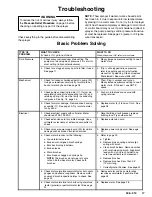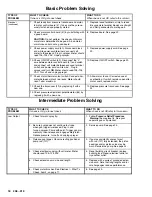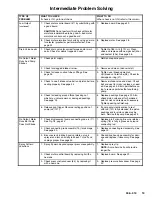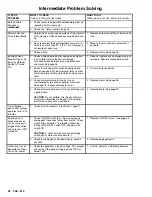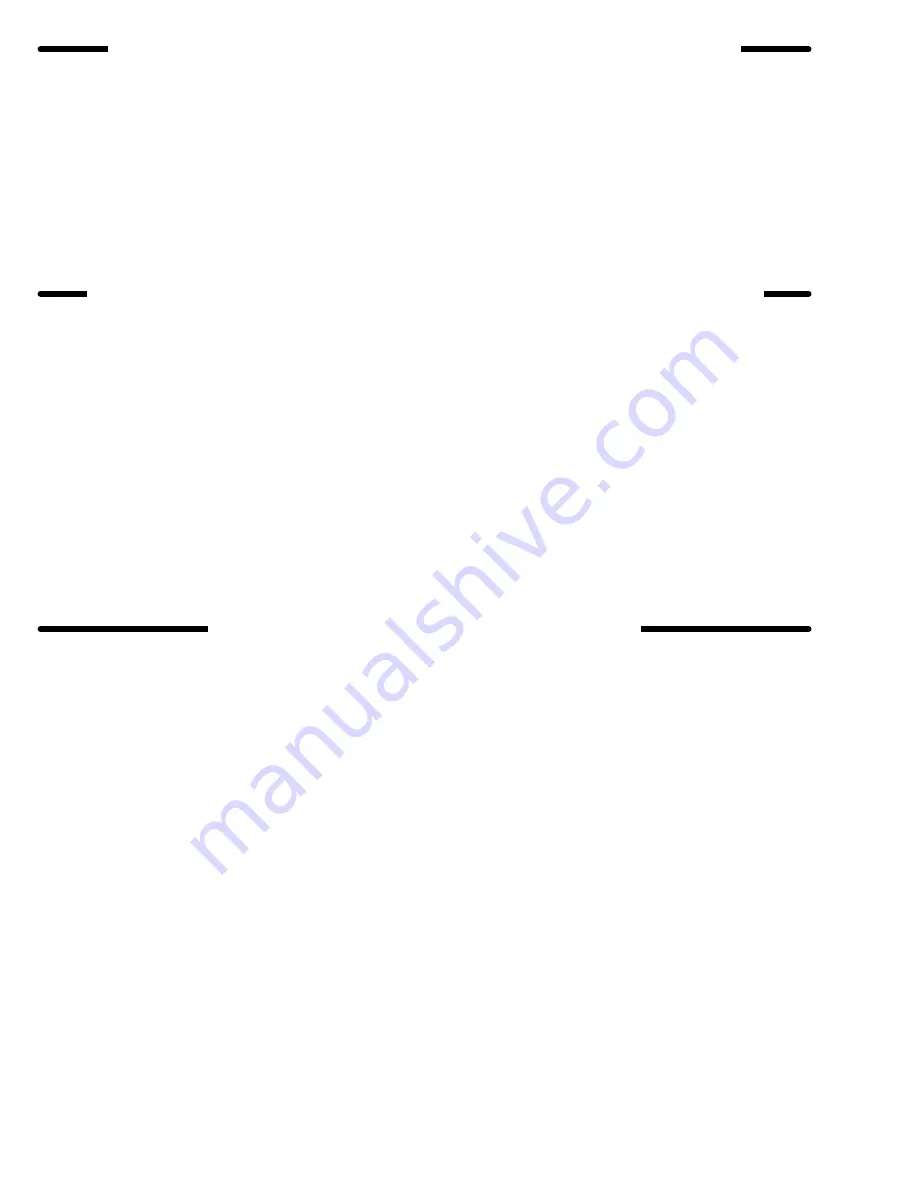
6
308-319
RISQUES EN CAS DE MAUVAISE UTILISATION DU MATERIAL
Consignes générales de sécurité
Toute utilisation anormale de l’appareil de pulvérisation ou des
accessoires comme, par exemple, la mise sous une pression
excessive, les modifications de pièces, l’utilisation de produits
chimiques et de matières incompatibles et l’utilisation de pièces
usées ou abîmées peut causer des dégâts à l’appareil ou des
ruptures de pièces et entraîner une injection de liquide ou
d’autrès blessures sérieuses, un incendie, une explosión ou
d’autrès dégâts.
Ne Jamais alterer ou modifier une piece de cet appareil; ceci
risquerait d’entraîner son mauvais fonctionnement.
Vérifier régulièrement tout l’appareil de pulvérisation et
ses
equipements et réparer ou remplacer immédiatement les
pièces usées ou abîmées.
Pression
Ce pulvérisateur peut produire une PRESSION MAXIMUM DE
TRAVAIL 195 bar (2750 lb/po2). S’assurer que tous les
éléments du pulvérisateur et ses accessoires sont conçus pour
résister à la pression maximum de travail de ce pulvérisateur.
NE PAS depasser la pression maximum de travail d’aucun des
éléments ou accessoires utilisés avec cet appareil.
Compatibilité chimique des corps
Bien s’assurer que tous les corps des solvants utilisés sont
chimiquement compatibles avec les parties mouillées indi-
quées dans les
Technical Data
, à page 39. Toujours lire soig-
neusement les documents et brochures du fabricant des fluides
et solvants utilisés avant de s’en servir dans ce pulvérisateur.
MESURES DE SECURITE CONCERNANT LES TUYAUX FLEXIBLES
Le fluide à haute pression circulant dans les tuyaux peut être
très dangereux. En cas de fuite sur le tuyau, de fissure, déchi-
rure ou rupture à la suite de l’usure, de dégâts ou d’une
mauvaise utilisation, les projections de fluide haute pression qui
en proviennent peuvent entraîner des blessures graves par
pénétration sous la peau ou par contact, ainsi que des dégâts
matériels.
Tous les tuyaux flexibles doivent avoir des ressorts spirale
de protection aux bouts!
Les spirales de protection contribu-
ent à eviter la formation de pliures, de boucles ou de nœuds sur
les tuyaux qui pourraient entraîner la rupture du tuyau à l’endroit
du raccord ou à son voisinagé.
Serrer fermement tous les raccords avant chaque utilisation. Le
fluide sous pression peut faire sauter un raccord desserre ou
produire un jet à haute pression s’échappant par le raccord.
Ne Jamais utiliser un tuyau endommagé. Ne Pas essayer de
refaire le raccord d’un tuyau haute pression ni de réparer le
tuyau avec du ruban adhesif ou par tout autre moyen. Un tuyau
réparé ne peut pas résister au fluide sous pression.
Manipuler les tuyaux avec precaution et choisir soigneusement
leur chemin. Ne pas déplacer le fluide en tirant sur le tuyau. Ne
pas utiliser de fluides ou de solvants qui ne sont pas com-
patibles avec l’enveloppe intérieure ou extérieure du tuyau. NE
PAS exposer le tuyau à des températures supérieures à 82
C
(180
F) ou inférieures à –40
C (–40
F).
Continuité de la mise à la terre des tuyaux
Une bonne continuité de la mise à la terre des tuyaux est essen-
tielle pour maintenir la mise à la terre de l’ensemble de vaporisa-
tion. Vérifiez la résistance électrique de vos tuyaux à fluides et
à air, au moins une fois par semaine. Si votre tuyau ne comporte
pas d’étiquette qui précise la résistance électrique maximum,
prenez contact avec le fournisseur de tuyaux ou la fabricant
pour avoir les límites de résistance maximum. Utilisez un mètre
de résistance de la gamme appropriée pour votre tuyau et véri-
fiez la résistance. Si celle–ci dépasse les límites recom-
mandées, remplacez le tuyau immédiatement. Un tuyau sans
mise à la terre ou avec une mise à la terre incorrecte peut en-
traîner des risques pour votre systeme. Lisez aussi
LES
RISQUES D’INCENDIE OU D’EXPLOSIÓN
ci–dessus.
RISQUES D’INCENDIE OU D’EXPLOSION
De l’électricité statique est produite par le passage du fluide à
grande vitesse dans la pompe et dans les tuyaux. Si toutes les
pièces de l’appareil de pulvérisation ne sont pas convenable-
ment reliés à la masse ou à la terre, des étincelles peuvent se
produire et l’appareil risque d’être dangereux. Des étincelles
peuvent également se produire à l’occasion du branchement
ou du débranchement du cordón d’alimentation. Les étincelles
sont suffisantes pour allumer les vapeurs de solvants et le fluide
pulvérisé, les fines particules de poussieère ainsi que d’autrès
substances inflammables, et elles peuvent causer un incendie
ou une explosión, ainsi que des blessures graves et des dégâts
matériels. Toujours brancher le pulvérisateur dans une prise se
trouvant à au moins 6 m (20 pieds) de l’appareil et de l’endroit
où se fait la pulvérisation.
S’il se produit des étincelles d’électricité statique, ou si vous res-
sentez la moindre décharge,
arrêtez immédiatement la pulvé-
risation
. Vérifiez que le système entier est bien mis à laterre. Ne
vous servez pas du système avant que le problème soit identifié
et corrigé.
Mise à la terre ou à la masse
Pour réduire les risques de production d’étincelles d’électricité
statique, le pulvérisateur et tous les équipements utilisés ou se
trouvant dans la zone de pulvérisation doivent être reliés à la
terre ou à la masse. Pour connaître le detail des instructions de
mise à la terre dans la region et le type particulier d’équipement,
CONSULTER le code ou les réglementations électriques lo-
cales. S’ASSURER que tous les équipements de pulvérisation
suivants sont bien reliés à la terre:
1.
Pulvérisateur: Brancher le cordón d’alimentation ou la ral-
longe qui doivent être équipés d’une prise à 3 fiches en
bon état, dans une prise de courant convenablement mise
à la terre. Ne pas utiliser d’adaptateur. Toutes les rallonges
doivent avoir 3 fils et être prevues pour 15 ampères.
2.
Tuyaux flexibles: Afin d’assurer la continuité de la mise à la
terre, n’utiliser que des tuyaux comportant une mise à la
terre et ayant une longueur maximum combinée de 150 m
(1500 pieds). Se reporter également au paragraphe
Conti-
nuité du circuit de mise à la terre des tuyaux.
3.
Pistolet: Réaliser la mise à la terre en le raccordant à un
tuyau flexible et à un pulvérisateur dèjá convenablement
reliés à la terre.
4.
Récipient d’alimentation: observer le code ou les régle-
mentations locales.
5.
Objets, matériel ou surfaces reçevant la pulvérisation: ob-
server le code ou les réglementations locales.
6.
Tous les seaux de solvants utilisés pour le rinçage: ob-
server le code ou les réglementations locales. N’utiliser
que des saux métalliques conducteurs de l’électricité. Ne
pas mettre le seau sur une surface non conductrice
comme sur du papier ou du carton car cela interromprait la
continuité de la mise à la terre.
7.
Pour conserver la continuité de la mise à la terre quand on
rince le matériel ou quand on libére la pression, toujours
maintenir une partie métallique du pistolet fermement ap-
puyée contre le côté d’un seau en métal puis appuyer sur
la détente du pistolet.
Mesures de sécurité concernant le rincage
Pour réduire les risques de blessures par pénétration de la
peau et les risques dûs aux etincelles d’electricite statique ou
aux éclaboussures, observer la marche à suivre pour le rincage
donnée à la page 15 de ce manuel. Observer la “Marche à
Suivre pour Détendre la Pression” donnée à la 5 en
enlever
l’ajutage du pulvérisateur avant le rincage. Maintenir une partie
métallique du pistolet fermement appuyée contre le côté d’un
seau en métal et utiliser la pression la plus faible possible pen-
dant le rincage.

















